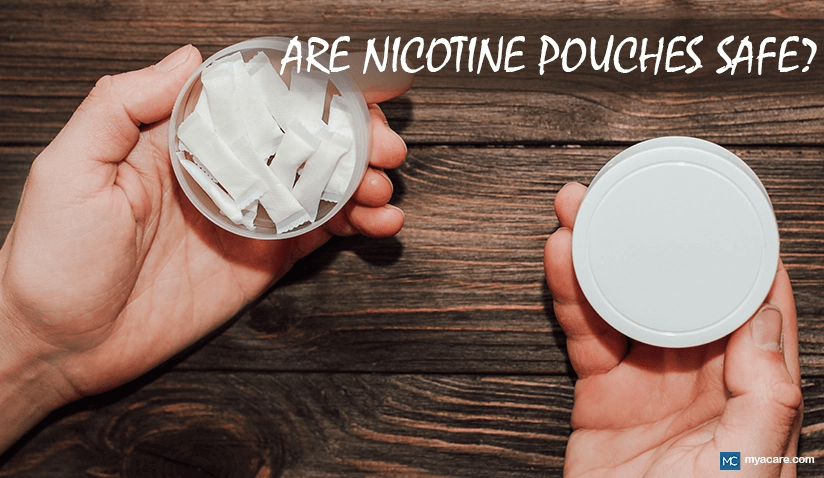Nicotine Pouches: Health Benefits, Risks, and More

Medically Reviewed and Updated by Dr. Shilpy Bhandari - August 8, 2024
Nicotine pouches have been gaining popularity as a tobacco-free alternative to traditional smoking since their introduction to the market in 2019. Research suggests an exponential increase in the sales of nicotine pouches from 126.06 million units in 2019 to 808.14 million units in 2022. Given their growing popularity, it is important to know more about the safety and effectiveness of nicotine pouches. This article examines the health benefits, potential risks, and other important information about nicotine pouches.
What are Nicotine Pouches?
Nicotine pouches are small, preportioned pouches (~25 mm in length) containing nicotine and other ingredients. The user places a nicotine pouch between the gum and lip, where the nicotine enters the bloodstream through the mouth’s lining.
Nicotine pouches are often marketed as a non-tobacco alternative to traditional smoking, making them appealing to those wanting to give up on smoking or reduce their tobacco intake. They come in various flavors and strengths, making them a customizable user option.
What are the Ingredients in Nicotine Pouches?
The main ingredient in nicotine pouches is nicotine of a pharmaceutical grade extracted from tobacco plants.[1]
Other ingredients vary depending on the brand and flavor. Some common ingredients found in nicotine pouches include:
- Plant fibers: These are used as the base for the pouch, providing structure and helping nicotine delivery. Fibers are organic cellulose compounds that create a non-woven fleece, and the thickness of this fleece influences how quickly the nicotine is released. Standard fibers come from sources like eucalyptus or pine.[2]
- Flavorings: To enhance taste, nicotine pouches often contain natural or artificial flavors, such as black cherry, citrus fruits, peppermint, and coffee. Among these, peppermint is the most commonly used flavoring.
- Sweeteners: Most brands use sweeteners such as xylitol or maltitol to make the pouches more palatable, particularly because nicotine has a bitter flavor.
- pH adjusters: Sodium carbonate (bicarbonate) is commonly used to regulate the pH balance within the pouch to ensure it is alkaline. However, this may cause mouth irritation in some people.
- Binders and Fillers: These ingredients determine the speed of nicotine release and how the pouch feels in your mouth. These comprise microcrystalline cellulose (a white powder that absorbs nicotine), gum, and a hydrophilic solvent (e.g., water which helps maintain the pouch's moisture level). About 80-90% of a nicotine pouch is composed of water and microcrystalline cellulose.
Other ingredients are present in nicotine pouch formulations, some of which may not be standardized. In a study of 48 nicotine pouches, 186 ingredients were identified, three of which are classified as “potentially carcinogenic to humans”[3], and in the EU, 13 ingredients lack authorization to be used as flavors.
How Do Nicotine Pouches Work?
Nicotine pouches work by delivering nicotine into the bloodstream through the lining of the mouth. When placed between the gum and lip, the nicotine is absorbed into the bloodstream, providing a similar effect to cigarette smoking. Unlike cigarettes, the full effect takes longer to manifest and provides a slower continuous effect.[4]
How Long Do Nicotine Pouches Last?
Nicotine pouches are available in concentrations ranging from 1.29 to 11 mg per pouch, varying by brand. Depending on the brand and the concentration, nicotine pouches may last from 30 minutes to an hour in the mouth. Subsequently, the pouch should be discarded.
By comparison, cigarettes last only up to 7 minutes.
What is the Immediate Effect and Experience When Using Nicotine Pouches?
The immediate effect of using a nicotine pouch is the feeling of relaxation and alertness. This effect is due to the way nicotine triggers dopamine release in the brain, which creates feelings of pleasure and satisfaction. Users may also experience a tingling sensation in the mouth, similar to the feeling of using chewing tobacco.
Potential Benefits of Nicotine Pouches
Nicotine pouches have acquired a reputation as a safer alternative to traditional smoking, and they may have some potential benefits.
- Tobacco-free: Nicotine pouches do not contain tobacco leaves, making them a potentially safer option for those looking to reduce their tobacco intake.
- Convenient: Nicotine pouches are noncombustible, discreet, and easy to use, making them a convenient option for those who want to use nicotine without the hassle of smoking or vaping.
- Customizable: With various flavors and strengths, nicotine pouches are customizable to the individual’s preferences.
- Possible smoking cessation tool: Some users have found success in using nicotine pouches as a tool to quit smoking or reduce their tobacco intake. However, it is important to note that despite anecdotal reports, there is no evidence to support these claims.
Why Do Nicotine Pouches Burn?
Sensitive users may experience burning sensations when using nicotine pouches. Burning is likely the result of the pH adjusters used in the pouch, which can irritate the mouth. The pH must be high (alkaline) to allow the nicotine to enter the bloodstream. Often safe ingredients such as sodium bicarbonate are used to moderate the pH. There are also rules and regulations to ensure the pH is not too high to burn the inside of the mouth.
If this sensation becomes too uncomfortable, it is recommended to discontinue use.
What Happens if You Swallow a Nicotine Pouch?
Swallowing a nicotine pouch is not recommended, because it can cause nausea, vomiting, headache, dizziness, indigestion, and abdominal pain. If you accidentally swallow a pouch, it is important to seek immediate medical attention.
Risks and Side Effects of Nicotine Pouches
While nicotine pouches may appear as a safer alternative to conventional smoking, there are still some risks to consider.
- Addiction: As mentioned, nicotine is a highly addictive substance, and using nicotine pouches can lead to dependence and withdrawal symptoms.
- Lack of regulation: Nicotine pouches are not currently regulated by the FDA, meaning there is no guarantee of the ingredients or safety of the product.
- Potential for trace amounts of tobacco: While marketed as a non-tobacco alternative, some nicotine pouches may still contain trace amounts of tobacco-derived nicotine.
- Increased heart rate and blood pressure: Nicotine can cause an increase in heart rate and blood pressure, which can be dangerous for those with underlying heart conditions. However, some research reveals no risk concerning nicotine and heart disease in healthy individuals.
- May enhance tumor growth: Some studies show that nicotine can promote blood vessel growth, which can potentially increase the growth of existing tumors. However, more research is needed to verify this observation [5]. Other data suggests there are trace amounts of possibly carcinogenic substances in nicotine patches derived from the tobacco plant.[6]
- Flavorings may be toxic: Some nicotine pouches contained flavorings that caused the cells lining of the mouth to become overly toxic and inflamed.[7]
- Suitability risk: Some nicotine pouches contain ashwagandha and caffeine, which may not be suitable for everyone who wants to use them.
- Mouth irritation: The constant placement of pouches in the mouth can cause irritation and soreness in the gums and lips. Other similar nicotine products can burn the mouth or the skin similarly, including nicotine gum, lozenges, and patches[8]. Nicotine pouches may also lead to coughing, hiccups, and a runny nose.
Misconceptions About Nicotine-Free Pouches
Some brands may market their nicotine pouches as “nicotine-free,” but this is not entirely accurate. While the pouch itself may not contain nicotine, it may still contain trace amounts of tobacco-derived nicotine. Reading the ingredients and research before assuming a genuinely nicotine-free product is essential.
Nicotine pouches are also touted as smoking cessation tools. While other nicotine-containing products can potentially help smokers quit smoking, nicotine pouches have not been tested in this capacity yet.
Comparing Nicotine Pouches to Other Options
Nicotine pouches are just one of many options available for those looking to use nicotine without traditional smoking. Here is how they compare to other options:
- Nicotine gum: Nicotine gum is another tobacco-free option that delivers nicotine through the mouth’s lining. However, it requires chewing and may not be as discreet as pouches.[9]
- Nicotine lozenges: Like gum, nicotine lozenges are placed in the mouth and dissolve to deliver nicotine. They may not be as discreet as pouches and can cause throat irritation.
- Nicotine Replacement Therapies (NRTs): This category includes patches, inhalers, and nasal sprays designed to release nicotine gradually. These are FDA-approved for smoking cessation and might be preferred by those looking for a highly regulated approach to quitting.[10]
- Vaping: Vaping involves inhaling nicotine through an electronic device. While it may be a tobacco-free option, there are still major health risks associated with vaping[11], such as the development of lung injury (EVALI).
- Traditional smoking: Traditional smoking involves inhaling tobacco smoke, which can lead to a medley of health issues. These include coronary artery disease and COPD[12].
Legal Landscape and Age Restrictions
Nicotine pouches are currently not regulated by the FDA, meaning there are no age restrictions for purchasing or using them. There is also a lack of regulations regarding how they are advertised or taxed[13]. However, some states and countries have implemented age restrictions, so it is important to check local laws before purchasing.
Research and Advancements
While nicotine pouches are promoted as a potentially less toxic alternative to cigarettes, it is crucial to acknowledge that long-term research on their health impact is scarce.
Researchers are currently analyzing the potential risks and benefits of nicotine pouches. Studies are looking at how they affect the body, their efficacy for smoking cessation, and their potential appeal to various population groups. The results will shape future guidance on their use.
Conclusion
Nicotine pouches are a tobacco-free alternative to traditional smoking, but they still come with potential risks and side effects. It is essential to research and consult with a healthcare professional before using nicotine pouches or any other nicotine product. While they may have potential benefits, weighing the risks and making an informed decision is essential.
To search for the best dentists in India, Malaysia, Singapore, Spain, Thailand, Turkey, the UAE, UK and the USA, please use the Mya Care search engine.
To search for the best healthcare providers worldwide, please use the Mya Care search engine.
The Mya Care Editorial Team comprises medical doctors and qualified professionals with a background in healthcare, dedicated to delivering trustworthy, evidence-based health content.
Our team draws on authoritative sources, including systematic reviews published in top-tier medical journals, the latest academic and professional books by renowned experts, and official guidelines from authoritative global health organizations. This rigorous process ensures every article reflects current medical standards and is regularly updated to include the latest healthcare insights.

Dr. Shilpy Bhandari is an experienced dental surgeon, with specialization in periodontics and implantology. She received her graduate and postgraduate education from Rajiv Gandhi University of Health Sciences in India. Besides her private practice, she enjoys writing on medical topics. She is also interested in evidence-based academic writing and has published several articles in international journals.
Sources:
Featured Blogs



